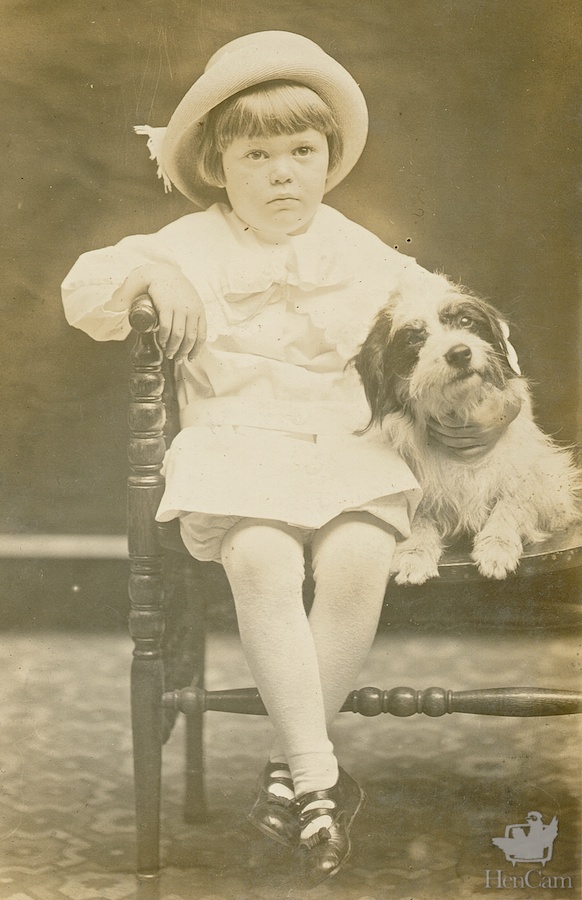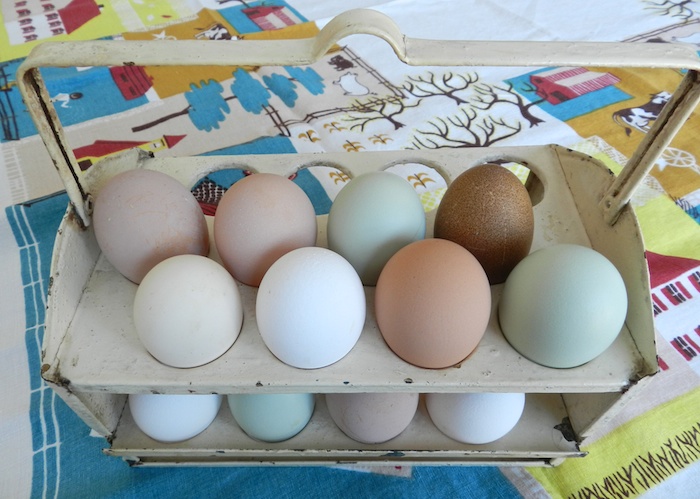I’ve noticed, in my collection of vintage photographs, that animals, even doted on lap dogs, are left scruffy. Unkempt even. These weren’t animals as fashion accessories, but rather companions that were expected to do the things that animals do. I’m hopeful that after the photo shoot, that this little girl got out of her pristine white outfit, put on her woolen leggings and worn jumper, and went on adventures with her dog. She certainly looks like she’s done with that bow and romper, doesn’t she?
Monthly Archives: January 2014
Tools for the Coop
I’m a firm believer that having the right tools can transform a chore into an agreeable activity. This is true in my kitchen. I’m not one to use a lot of gadgets, but having well-made tools makes the process of cooking a pleasure. Put a sharp knife in my hand, and a seasoned wood cutting board under it, and I feel competent and happy. Hand me a dull knife and ask me to cut on one of those glass boards, and all I want is to get out of the kitchen.
The right tools can make or break your time in the chicken coop, too. Like in the kitchen, you don’t have to have a lot of tools, but they do have to be appropriate for the job and be in good shape. I learned this very early on. When I was sixteen, I spent 10 weeks at a riding school in England. There were three brooms for a dozen girls, and only one of the brooms had full, sturdy bristles. Woe to the girls who had to sweep with the worn out brooms! We’d hurry to the stable yard, hoping to be the first one there to grab the good broom. To this day, I get great satisfaction sweeping with a new broom.
Keeping the coop clean and dry is the first line of defense against disease and parasites. My routine is made easy with these tools:
(from left to right)
You can’t cleanup without the right-sized muck tub (big enough so that the pitchfork fits, but not so large that it’s too bulky or heavy to carry.)
The metal rake is for tidying up the outside pen. It helps to loosen the dirt and remove manure.
The broom is both for sweeping up the floor, and also for getting down cobwebs. Cobwebs are reservoirs of bacteria and viruses. Sweep them out!
A plastic barn shovel is lightweight and wide and the perfect size for innumerable tasks. Once you have one in your barn, you’ll never know how you functioned without it.
A kitty litter scoop is good for quick pickups, and I also use it to clean manure out of nesting boxes. Spend a little extra money on a metal one. The plastic scoops break when kept outdoors.
A scrub brush is necessary for keeping waterers clean.
A good pair of scissors for opening bags and cutting baling twine (and once in a rare while for cutting a sticky fly strip off of a hen’s back!)
The fine-tined plastic pitch fork sifts out manure and leaves clean shavings. This will be a money saver for you as you’ll throw out less bedding.
A dustbin and brush is handy for cleaning in corners and wiping off nesting boxes.
Finally, make sure that your tools have an organized storage place. Hang them up where they are easy to reach and yet out of the way (if you have goats, you know how important it is to have passages clear and tools stowed where the goats can’t reach them to “help.”)
Have I left out your favorite chicken coop tool?
In another post I’ll list the things needed to setup a coop, like waterers and grain bins.
* Please note that I have Amazon links to these tools so that you can get an idea of pricing. I have not necessarily purchased items through these online stores. However, if you do shop Amazon, please start by clicking through a link on my site. I’ll get a small commission from Amazon, which helps to support HenCam. Thanks!
The Morning Wait
Egg Color/Ear Color
A few years ago a marketing arm of an industrial egg producers group put out a press release stating “brown chickens lay brown eggs and white chickens lay white eggs.” This erroneous factoid got into such prestigious magazines as Gourmet. While it is certainly true on factory farms, where there are only white or brown hens, that produce only white or brown eggs, it is certainly not true anywhere else. Actually, there is no correlation between feather color and egg color. Although wouldn’t that be fun, if, for example, my black and white hen Veronica laid black and white eggs?
There is, however, some correlation between egg color and earlobe color. The rule of thumb is that a white-lobed hen lays white eggs, while red-lobed hen lays brown eggs. People love to hear this bit because it sounds so outlandish. No one even thinks about a hen’s ears! Unlike many animals, the chicken’s ears don’t stick out, and they are somewhat covered by swirls of small feathers. As the saying goes, out of sight, out of mind. Although the entrance to the ear is hidden, you can often see the earlobe, which is a patch of soft skin. In some hens it’s obvious, and in some it’s not.
Twiggy’s white lobe is that blob to the lower left of her eye. Note that it is white and she does indeed lay white eggs.
Like Twiggy, Opal has white feathers, but her earlobe is red, and she lays brown eggs.
If the white ear/white egg correlation held true, then Misty would produce white eggs. She is a Blue Andalusian, which the books say have white earlobes, thus the “rule” says that she will lay white eggs. There are her earlobes. White.
Oh, wait. On a closer look, Misty’s earlobes are tinged with blue. This does not mean that she lays a blue egg. The egg that she does lay has a faint beige tint to it. Here it is on the top front row on the left. Twiggy’s pure white egg is next to it.
And what of the eggs that are neither white nor brown? What of blue, olive, green and chocolate? What of eggs with speckles? A fairly accurate rule is that hens with white lobes are limited to laying white eggs, but hens with reddish lobes can lay brown eggs, or eggs of other colors. (Yes, I am aware of hens with black lobes, and rare white-lobed hens that lay brown eggs, but I am trying for a sensible clarification here!)
The best known of the colorful egg laying breeds are the Araucanas and Americaunas. These chickens have reddish lobes – not that you can easily see them under their muffs and tufts! This is Beatrix. She lays dusky blue eggs. (The blue eggs in the above photo were laid by Owly.)
In true, there is a far wider variation in feather color, egg color, and earlobe color than any “rules of thumb” or marketing board press releases would have you think. I say, embrace that diversity. It makes the chicken yard, and the world, a much more interesting place.
Upcoming Events
My schedule, in the next few months, is busy.
On February 15, I’m looking forward to a cozy afternoon, sitting around the pellet stove at Cluck! in Providence, RI, and chatting about backyard chickens. The following weekend I’ll be at my local Agway in Chelmsford, MA, to talk about chick care. Later in the month I’ll be at the Concord Integrated Preschool’s book fair. Come and say hello to Veronica and buy a copy of Tillie Lays an Egg. In March I’ll be at bookstores in Concord, MA and Milford, NH to talk about my new title, The Farmstead Egg Guide and Cookbook. Also in March, I’ll be doing a Chicken Keeping Talk at the Newbury, NH library. Details about these programs are on my Upcoming Events page. More programs are scheduled all the way into summer, so take a look and check back often.
The schedule is busy, but not full. There’s still time to engage me for a school visit (details here) or a chicken keeping program.
I hope to see you soon!










